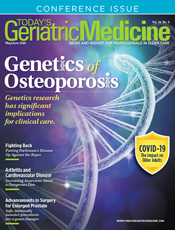
May/June 2020
The Last Word: Reversing the Decline of the Geriatrics Workforce — Understanding the Roots of the Shortage There’s a dire shortage of geriatricians in the United States—and a fast-growing number of people who need them—as recently reported in The New York Times. Our society is radically changing, becoming the oldest it’s ever been, with an estimated 30% of the population of individuals 65 and older requiring treatment from geriatricians for their complex needs. Rather than naturally expanding to meet the impending increase in demand, the field of geriatrics is actually shrinking, as evidenced by the decline in the number of trainees between 2012 and 2017, leaving many older adults without the care they deserve. Not only is our geriatrics workforce unprepared, but the time to prepare them is also largely passed. We’ve officially entered catch-up mode. To reverse the decline, we must first understand the root causes of the geriatrician shortage and the issues at play. Ageism The prejudice of ageism may be one reason trainees avoid the field that helps older people—and as a result, unwittingly increases the harm associated with ageism. A Pipeline to Where? Again, future earnings may be a factor. When geriatricians very much deserve to be rewarded, disincentives often penalize them for the type of care they provide to medically and socially complex older adults. This is further compounded by the frustrations among geriatricians who often cannot provide the care they want to because of the lack of integration in social and medical services in nonspecialized settings (eg, in a general primary care practice), despite the fact that that’s exactly where geriatricians need to be—part of the frontline workforce. Across the country, this impairs the effectiveness of geriatrics and, by extension, the whole field. In the end, geriatricians have something of a chicken-and-egg problem on their hands. The fact that there are too few geriatricians across our health systems makes it challenging for their powerful impact to be seen—and, by extension, for them to become role models for potential trainees. Consequently, too few trainees pursue geriatrics, the existing systems fail to create jobs for them, and once again, the interest in pursuing geriatrics is stifled. Building a Better Future for Geriatricians Local jurisdictions could consider replicating the GWEP model to create more local opportunities for geriatricians to teach front-line primary care teams and social service providers how to collaborate more effectively in caring for older people. Additionally, incentivizing trainees by offering generous loan repayment for those who pursue geriatrics or geriatric training in all professional health programs can yield such additional growth. We need to address ageism head-on at the systems level. Those of us in geriatrics and gerontology need to be clear that this is a social justice issue worthy of committed and passionate trainees. Nowhere else is there such opportunity to address stark inequalities, stigmatized disabilities, and underaddressed social determinants of health that affect older people and their social support systems. Speak up—when you are navigating older age, when your parents are, when your chosen family members are. The future will be older, wiser, and more diverse. But if we don’t do something now, it will also continue to be underresourced, unhealthy, confusing, frustrating, undignified, and unjust for most older Americans. — William A. Haseltine, PhD, is the chair and president of ACCESS Health International, a nonprofit organization he founded in 2007. ACCESS Health fosters innovative solutions to health care challenges in the United States and internationally. Haseltine was a professor at Harvard Medical School and Harvard School of Public Health from 1976 to 1993, where he was founder and the chair of the division of biochemical pharmacology and the division of human retrovirology. He is the founder of Human Genome Sciences Inc, and served as the chairman and CEO of the company until 2004. He is well known for his pioneering work on cancer, HIV/AIDS, and genomics. His most recent books are Aging Well and Voices in Dementia Care. — Anna Chodos is an assistant professor of medicine at UCSF. Clinically she practices geriatrics and primary care in the San Francisco Health Network, the city’s large integrated safety net health care system. Her passion is to improve primary care for vulnerable older adults. |
